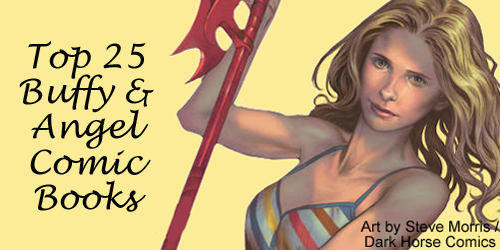For 21 years, from 1998’s short story “Maguffins” through 2018’s Joss Whedon-penned “The Reckoning,” Buffyverse stories unspooled in comic books – with Buffy always having a home at Dark Horse and Angel and Spike making a brief foray over to IDW in the middle years. For most of this time, four-color “Buffy” and “Angel” stories were fans’ lone source of further adventures.
While the license has since moved over to Boom! Studios, which is doing a re-imagining, it’s unlikely that anything can top the originals. They featured a mix of top-shelf industry writers with TV writers (including Whedon himself) dipping their toes into a new medium – and succeeding more often than not.
Artists such as Georges Jeanty, meanwhile, gave us artistic yet faithful versions of the Scooby Gang and Angel Investigations.
In the early days, Dark Horse’s vintage series kept us occupied on days that weren’t Tuesday. Then Seasons 8-12 (along with a handful of other titles, such as “Angel: After the Fall”) gave us the canonical continuation from the TV series, directly overseen by Whedon.
Here are my picks for the 25 best “Buffy” and “Angel” comics from the Dark Horse/IDW era, listed in timeline chronological order:
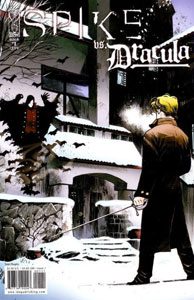
“Spike vs. Dracula”
Five-issue series, 2006
Peter David pens a delicious time-hopping romp from the turn of the 20th century through “Angel” Season 5 as the titular alpha vampires clash. Dracula — a surprisingly key player in the canonical comics — is amusingly traditional, much to the ire of Spike, whose personality seeps from James Marsters’ portrayal into these pages. Somewhat similar to the novel “Spike and Dru: Pretty Maids All in a Row” — and somewhat like “Forrest Gump,” actually — the vampires interact with several key points in history. It’s always fun to see nationalist Spike happily draining Hitler’s forces in the name of England. (Full review.)
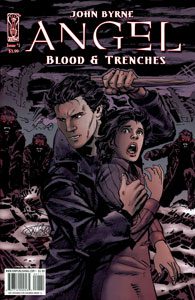
“Angel: Blood & Trenches”
Four-issue series, 2009
IDW cranked out several pre-Sunnydale “Angel” stories, but the first is the best. Writer-artist John Byrne captures the psychological and physical pain of what it’s like to be a vampire with a soul as narrator Angel tries to minimize casualties in World War II while being hated by vampires, Watchers and soldiers on both sides. Byrne invents several awesome moments, such as hungry vampires rising from snowbanks and Angel diving into a frigid river to escape sunlight. Drawn only in pencil, “Blood & Trenches” is nonetheless wonderfully detailed, and the splashes of red on the more violent pages allow us to see the point of view of good guys such as Wesley’s ancestor, a member of the Watchers’ Council. (Full review.)
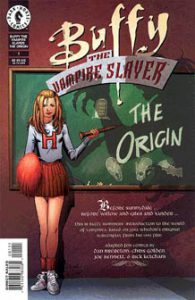
“The Origin”
Three-issue series, 1999
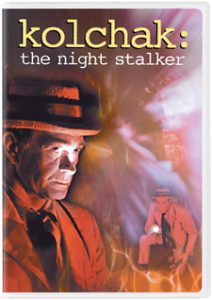
Whedon’s movie screenplay – not the movie itself – gets adapted in order to fit with the continuity, timeframe and likenesses of the TV series. (See review in “10 essential classic ‘Buffy’ comics.”)
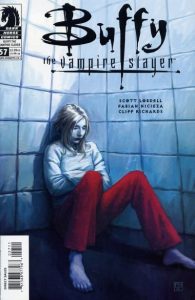
“Slayer, Interrupted”
“BTVS Classic” Issues 56-59, 2003
This prequel to “Normal Again” (6.17) chronicles Buffy’s time in a mental institution before she moves to Sunnydale. (See review in “10 essential classic ‘Buffy’ comics.”)
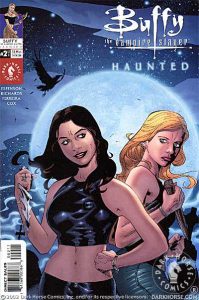
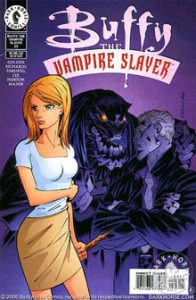
“The Blood of Carthage”
“BTVS Classic” Issues 21-25, 2000
Christopher Golden’s best spinoff fiction comes in the novels, but this Season 4 yarn proves he can write comics too. He crystalizes Buffy’s normality-versus-duty conflict as the Slayer converses with Willow: “I want a life. But I don’t want anyone else to pay for it.” While “BTVS” Classic regulars Cliff Richards and Joe Pimental do most of the art, Chynna Clugston-Major gives us heartachingly cute flashbacks to 8-year-old Xander and Willow. Xander is of course a free-range kid, but Willow deals with her overbearing mother, who is displeased with Xander’s supposed bad influence on her daughter. (Full review.)
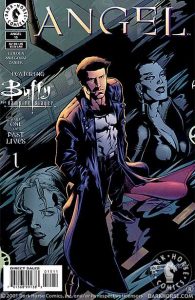
“Past Lives”
“Angel Classic” Issues 15-16 and “BTVS Classic” Issues 29-30, 2001
Golden and Tom Sniegoski achieve a high point in the “Angel Classic” series with one of Golden’s staples: a rogue Watchers’ Council operative, in this case the Angel-loathing Alexa. This is a strong example of one of the TV series’ go-to concepts: someone from Angelus’ past targets Angel and his current friends, something he sympathizes with but can’t let stand. The spillover into Buffy’s Season 4 world allows the Slayer and Giles, along with Quentin Travers, into the picture for a team-up that can respectably stand with the WB New Tuesday crossover events from that season. (Full review.)
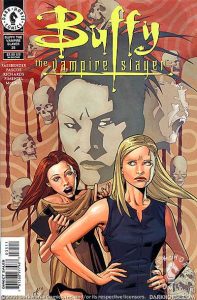
“False Memories”
“BTVS Classic” Issues 35-38, 2001
In what arguably should’ve been an actual Season 5 episode, the question of how much everyone knows about Dawn’s true nature gets ironed out. (See review in “10 essential classic ‘Buffy’ comics.”)
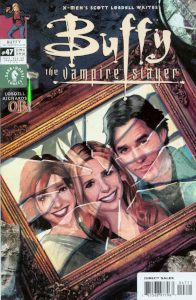
“Note from the Underground”
“BTVS Classic” Issues 47-50, 2002
Scott Lobdell (“X-Men”) and Fabian Nicieza (“Deadpool”) start their excellent run on “BTVS Classic” with a smart post-Season 6 crossover with the “Angel” gang, plus Faith on one of her many jailbreaks. Willow and Spike — who dominated Season 6 — are otherwise occupied, allowing for a refreshingly different group dynamic. The authors give us a superior version of the Season 4 arc as Adam is resurrected in evil digital form but Buffy outsmarts him by acting like Buffy, rather than by acting like a Slayer, as he expected. If Faith’s appearance isn’t enough fan service for ya, Buffy’s OG sidekick Pike drops in for his last appearance on the timeline. (Full review.)
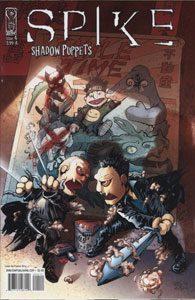
“Spike: Shadow Puppets”
Four-issue series, 2007
Spike has spent time in the Scooby Gang and logged hours with “Angel’s” group, but what’s less widely known is that there is a Team Spike in the comics. They are an entertaining bunch, ranging from a martial artist with a crush on Spike to a teenage fire-starting girl to a floating telepathic fish. Brian Lynch’s sequel to “Smile Time” (“Angel” 5.14) finds Team Spike and Lorne in Japan, where they of course get turned into puppets. In addition to the expected amusements such as Lorne accidentally ripping Spike’s arm off, “Shadow Puppets” does a Shane Black-style thing where it makes fun of its own heroes. For example, Spike narrates that he ducks behind a hot-dog cart upon hearing a car backfire — not because he’s scared, but to see if children are in peril. (Full review.)
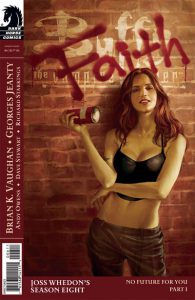
“No Future For You”
Season 8, Issues 6-9, 2007
“Daredevil” TV scribe Brian K. Vaughan’s only foray into the Buffyverse is a memorable one as he pens a Faith story with old-school rhythms, great dialog and sharp comedic timing. One of the problems of having 1,300 Slayers and no Watchers’ Council is that some of those Slayers will be evil (as sneak-previewed with Dana in “Angel” Season 5). Giles, sensing that Faith is a lot like he was at that age, assigns her to assassinate the twisted British Slayer Genevieve — but Faith ends up hitting it off with this fellow rogue Slayer. The Faith-Buffy-Giles loyalty triangle comes into fascinating light and Vaughan creates genuine tension about what side Faith will choose. (Full review.)

“Wolves at the Gate”
Season 8, Issues 12-15, 2008
TV writer Drew Goddard’s last Buffyverse arc is famous (or infamous) for Buffy’s sexual experimentation with younger Slayer Satsu, but the comedic timing as all of their friends walk in on them is hilarious. The highlight, though, is the thread featuring Xander and Dracula. Xander’s girlfriend Renee is shockingly killed (although maybe it shouldn’t be shocking, given Xander’s luck), and Dracula gets equally surprising development as he recognizes Xander’s grief and lets him target the vampire who killed Renee. “Wolves at the Gate” earns such goodwill that I forgive an over-the-top element: a Mecha-Dawn robot stomps and roars through Tokyo. (Full review.)

“Time of Your Life”
Season 8, Issues 16-19, 2008
I’m listing these stories in chronological order, but you should read “Fray” before this one; it’s a time-travel thing. Reteaming Whedon with artist Karl Moline, this is part two of the “Fray” trilogy as Buffy travels 200 years into the future. The interactions between the two Slayers are amusing, with Buffy trying to learn the future ‘Merican slang and lamenting that “The English language is just losing it. I should have treated it better.” Although we must wait to learn why the heck Future Willow is manipulating the timestream, we nonetheless get “Wish”-level goosebumps when Buffy is forced to kill the future version of her best friend, something that reaffirms her bond with the present-day Willow. (Full review.)

“Retreat”
Season 8, Issues 26-30, 2009
This arc kind of irks me because it overwrites Golden’s novel “Oz: Into the Wild” with flashbacks of Oz’s Season 4 walkabout, when he meets his wife, Bay. But I can’t deny it’s well-written. Espenson’s epic yarn has a foreboding “Empire Strikes Back” quality as the good guys regroup at a hastily formed base in Tibet and Twilight’s bad guys pursue them. During the down time, relationships blossom, and in a heartbreaking moment, Buffy realizes she likes Xander nine years and a couple issues too late; Xander and Dawn have likewise recently figured out they like each other. Issue 28 is the best of Season 8 as Andrew reprises his video investigation tactics from “Storyteller” (7.16) and utterly fails to find the spy in their midst: Amy in the form of a cat. (Full review.)
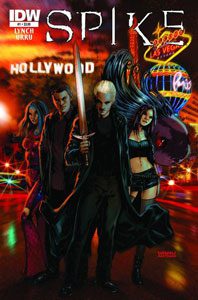
“Spike”
Eight-issue series, 2010-11
Generally, IDW did its thing with “Angel” while Dark Horse did its thing with “Buffy.” But the one time the companies team up, it results in IDW’s best work: Lynch’s “Spike” ongoing series that leads up to Spike’s debut in Issue 35 of “Buffy” Season 8. In a tasty parallel to Buffy’s pre-Sunnydale adventures in the “Origin” sequel “Viva Las Buffy!,” Sin City is where Spike discovers his newfound ability as a champion, leading Team Spike against the Vegas branch of Wolfram & Hart. Sadly, its Team Spike’s final appearance, but on the plus side, Willow comes into the picture. The story ties in with Spike’s acquisition of a soul (there’s always a price: someone else lost a soul), and we get the long-awaited return of the previously asylum-bound Drusilla. (Full review.)
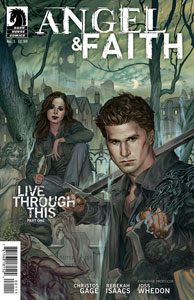
“Live Through This”
“Angel & Faith” Season 9, Issues 1-4, 2011
Christos Gage, who will go on to be the most prolific of the canonical Buffyverse writers, makes a strong debut, helped by the wonderfully expressive art of Rebecca Isaacs: Her details on Faith’s face are the next best thing to an Eliza Dushku performance. Starting here, the comics can finally kick back and do what the TV series couldn’t because of scheduling: a permanent team-up between the brooding vampire and troubled Slayer. They always trade off in keeping each other from the dark side, and this time it’s Faith’s turn as she warily eyes Angel’s bid to resurrect Giles. Season 8’s Angel-as-Twilight reveal was unsatisfying, but Gage sets out to redeem it via Angel’s own hopes to redeem himself, first by taking on Twilight’s nutso sibling allies Pearl and Nash. (Full review.)
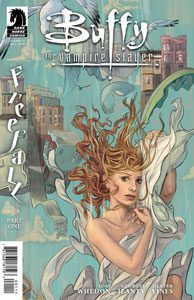
“Freefall”
“Buffy” Season 9, Issues 1-4, 2011
“Dollhouse” writer Andrew Chambliss smoothly guides “Buffy” back from the brink of the weak Season 8 ending by zeroing in on our favorite Slayer’s daily life issues. An amusing yarn about Buffy trying to recall the details of a drinking binge (which will pay off later) starts Season 9 on a down-to-earth note. Whereas TV has a tendency to skim over characters’ financial situations — after all, apartments have to be big enough to allow TV cameras to move around — that’s not a problem in comics. So we get details such as Buffy’s low-paying job as a barista and her San Francisco apartment where she can simultaneously touch both walls of her bedroom. (Full review.)
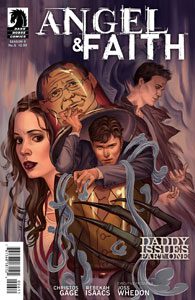
“Daddy Issues”
“Angel & Faith” Season 9, Issues 6-9, 2012
Giles was killed off before we got his full Ripper backstory, but never fear: As Angel acquires pieces of Giles’ soul in the manner of “Harry Potter,” we get flashbacks to Giles’ youthful rebellion in the 1970s. Meanwhile, Faith has an emotional reunion with her estranged father, Pat, who unfortunately is different from the father (George) in “Go Ask Malice: A Slayer’s Diary” — but such is the nature of licensed franchise fiction. The best “daddy issue” thread is actually Drusilla’s. She becomes sane — much to her consternation — under the influence of a Lorophage Demon, who recalls Bloodsucker from the Mirage “Teenage Mutant Ninja Turtles” arc “The River.” (Full review.)
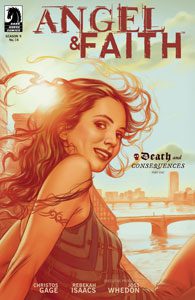
“Death and Consequences”
“Angel & Faith” Season 9, Issues 16-19, 2012-13
Gage gives us the elite Giles-as-Ripper flashback, as we see Giles’ and Ethan’s resurrection of Eyghon, an event that will have consequences for our heroes in present day. Sometimes the reuse of villains falls flat (see The First’s return in Season 7), but Eyghon is a good choice because we didn’t see him at full strength in “The Dark Age” (2.8). I love Giles’ grandmother’s lecture about how Giles’ teenage stupidity doesn’t preclude him from being a Watcher; rather, it makes him an ideal candidate for the job. Isaacs’ work on Angel is especially good here, as she conveys through his haunted eyes the stress of holding three entities (Angel, Angelus and Giles) within himself. (Full review.)
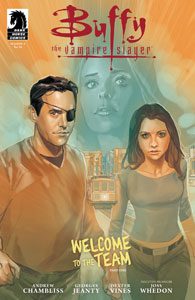
“Welcome to the Team”
“Buffy” Season 9, Issues 16-19, 2012-13
Illyria makes her debut on the “Buffy” side of the saga, as fascinatingly ambiguous as ever — she serves her own interests, but that sometimes coincides with that of the good guys. Colorist Michelle Madsen nicely illustrates how Dawn’s sickness is making her gradually disappear, and Gage does nice writing for Xander (who has been satisfyingly redeemed in the canonical comics), who is frustrated about having to choose between the two women he loves: Buffy, whom he wants to help, and Dawn, whom he wants to keep out of danger. Season 9 doesn’t try too hard to invent the Biggest Bads of all time, and that conservative approach is paying off as Severin and Simone creep around the margins trying to make abominations such as Slayer-zompires. (Full review.)
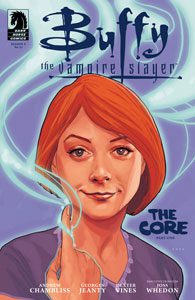
“The Core”
“Buffy” Season 9, Issues 21-25, 2013
The Buffyverse’s best comic season is perhaps driven by a friendly competition between the two titles, and at the finish line, “Buffy” edges out “Angel & Faith.” Generally, the comics don’t fully embrace Whedon’s mandate (from back on “Angel: Long Night’s Journey”) that they should be as kinetic as traditional superhero comics, but “The Core” busts loose with an epic conclusion among the vertically stacked sarcophagi of England’s Deeper Well. In what is unfortunately his Buffyverse swan song, Chambliss subtly uses Illyria’s experiences in the IDW comics to explain her newfound goodness, and we feel the pain of losing Dawn (in a nice dementia metaphor where her memories fade) and the satisfaction of getting her back. And Simone becomes a pretty cool Big Bad after all when she joins forces with the First Vampire and creepily tries to become a Slaypire (to borrow Xander’s term). (Full review.)
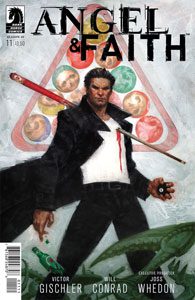
“United”
“Angel & Faith” Season 10, Issues 11-14, 2015
Season 10 is a down season for both “Buffy” and “Angel & Faith,” but this arc is an exception. Writer Victor Gischler brings back both Fred and Illyria, and their battle within the same body is a more overt answer to the Angel/Angelus situation. I feel like “Angel” Season 5 made it clear that Fred’s soul has been destroyed, but I forgive the comic for resurrecting her: We’re talking about Fred, after all. The lab setting where Illyria re-emerges evokes “A Hole in the World” (“Angel” 5.15) in both visuals and emotions. Although the resolution of the long-simmering mystery of who killed Koh’s family is exactly what we all assumed (it was Illyria), Koh’s reaction is so different from the cliche that it’s worth the wait. (Full review.)

“Dark Reflections”
“Angel” Season 11, Issues 9-12, 2017
Although better than Season 10, the shorter Season 11 still does not offer elite-level Buffyverse comics. An exception comes at the end of “Angel,” as writer Corinna Bechko spins a time-travel yarn wherein Angel and Illyria/Fred go back to the time when Darla sires Angelus. Although this is typical time-travel stuff, we feel Angel’s temptation to change events — or at least spend time with his sister, Kathy, the one family member he liked. Bechko hits us with one surprise, though: Angel’s hookup with Illyria — along with Fred’s acknowledgement that she could’ve vetoed Illyria’s decisions if she wanted to. I’ll avoid the “three-way” jokes, but seriously: How’s that for a love triangle? (Full review.)

“The Reckoning”
“Buffy” Season 12, Issues 1-4, 2018
Whereas the Buffyverse’s Seasons 8-10 consist of 50-plus issues each, and Season 11 has 28, Season 12 is merely these four issues. Dark Horse’s license was about to expire and go to Fox’s in-house brand, Boom! Studios. Given this logistical problem, “The Reckoning” is an outstanding final statement from Whedon and Gage, along with the saga’s elite artist, Georges Jeanty. This time-hopping yarn serves as part three of the “Fray” trilogy as everyone unites against the Big Bad Harth, and now we have the fun experience of seeing everyone try to understand Fray’s slang. We get a fresh approach to the final battle from the two champions: They’ll try to save the world, but without sacrificing anyone. Their ability to move away from either/or reasoning is Buffy’s and Angel’s biggest sign of maturation. (Full review.)
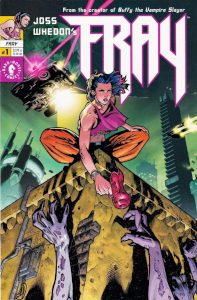
“Fray”
Eight-issue series, 2001-03
The first canonical Buffyverse comic, written by Whedon with world-building art by Moline and a vibrant futuristic palette by Dave Stewart, is still the best. Although he wrote it in 2001-03 while working on three (!) TV series, Whedon’s heart and mind are totally in it. Known for undercutting cliches with “Buffy,” here Whedon subverts internal Buffyverse cliches. It’s sometimes hilarious and always awesome as we learn about the new 23rd-century normal: Melaka Fray is the only Slayer in existence, but she doesn’t have Slayer dreams — her twin brother, the vampire Harth, does. And in this future city (a classic dystopian combo of ruins and tech), no one knows what a Slayer is — quite a change from 200 years ago. As with “Firefly,” Whedon goes to the trouble to show the change in language — in this case via new terminology such as “lurks” (vampires), “grabbers” (thieves) and “Haddyn” (Manhattan). It’s smart stuff, yet this isn’t homework: The gritty yet empathetic Fray is a perfect tour guide. (Full review.)
Honorable mention: Top 10 standalone issues
- “Ring of Fire” (2000)
- “Giles: Beyond the Pale” (2000)
- “Night of a Thousand Vampires” (“BTVS Classic” Issue 39, 2001)
- “Doyle,” “Connor” and “Illyria” issues of “Angel: Spotlight” (2006)
- “Last Angel in Hell” (2009)
- “After These Messages … We’ll Be Right Back” (Season 8, Issue 20, 2008)
- “Women of a Certain Age” (“Angel & Faith” Season 9, Issue 10, 2012)
- “Spike and Faith” (“Angel & Faith” Season 9, Issue 20, 2013)
Click here to visit our “Buffy”/“Angel” Zone.
Related: John’s top 20 “Buffy” episodes

